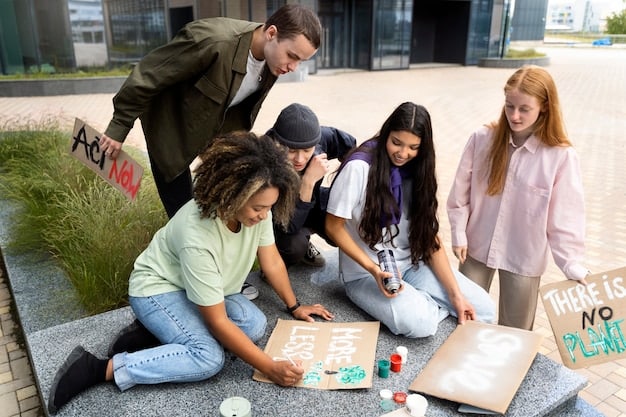Trauma-Informed Education: 4 Elements for Gen Z in 2025

Trauma-informed education for Gen Z in 2025 focuses on creating supportive, understanding learning environments that acknowledge the impact of adverse experiences, prioritize safety, build strong relationships, foster emotional regulation, and empower student resilience through holistic pedagogical practices.
The educational landscape is in perpetual flux, continuously adapting to the evolving needs of each new generation. For Gen Z students, a cohort shaped by unique global challenges and pervasive digital connectivity, traditional pedagogical approaches often fall short. A critical paradigm shift is underway, recognizing that many young learners carry experiences that can impede their ability to learn and thrive. This pivotal shift introduces the concept of a trauma-informed approach to education for Gen Z students in 2025, a framework designed to foster resilience, well-being, and academic success by understanding and responding to the pervasive impact of trauma.
Understanding the Gen Z Educational Landscape
Gen Z, broadly defined as individuals born between the mid-1990s and the early 2010s, stands apart from previous generations in several key respects. They are digital natives, having grown up with the internet, social media, and mobile devices as integral parts of their daily lives. This pervasive connectivity, while offering unparalleled access to information, also exposes them to a constant stream of news, both positive and negative, often without the protective filters that older generations might have experienced. Economic uncertainties, social justice movements, and a global pandemic have cumulatively etched deep imprints on their collective psyche, contributing to levels of stress and anxiety that demand thoughtful consideration within educational settings.
The academic environment, once seen primarily as a place for intellectual pursuits, is increasingly recognized as a crucial space for social-emotional development. For Gen Z, who have navigated a world rife with complex stressors—from climate change anxieties to school safety concerns and the profound isolation of lockdown periods—the traditional “one-size-fits-all” model of education is inadequate. Educators are now faced with the imperative of creating environments that not only impart knowledge but also serve as bastions of safety, understanding, and healing.
The Impact of Digital Fluency and Global Events
Gen Z’s digital fluency means they process information differently. They are adept at multitasking and consuming content quickly, but this also contributes to shorter attention spans and a preference for visual, interactive learning experiences. Simultaneously, their exposure to global events, often unfiltered, can lead to vicarious trauma and a heightened sense of vulnerability. It’s not just personal adverse experiences that shape them; it’s the collective trauma of a world in constant flux, witnessed through screens.
- Constant exposure to news cycles and social media.
- Increased awareness of global crises and social injustices.
- Shifting expectations for learning environments and teacher-student relationships.
- Blurred lines between immediate personal experiences and broader societal issues.
Furthermore, the aftermath of the COVID-19 pandemic cannot be overstated. It disrupted routines, forced unprecedented reliance on virtual learning, and, for many, involved significant personal loss or overwhelming stress. These experiences have left an indelible mark, manifesting as increased anxiety, depression, and learning setbacks. Therefore, approaching education for this generation without acknowledging these foundational experiences would be a disservice, hindering their true potential. The imperative is clear: education in 2025 must be deeply empathetic and intentionally trauma-informed.
Element 1: Safety and Trust – Building Secure Foundations
At the core of any effective trauma-informed approach is the foundational principle of safety and trust. For students, particularly those who have experienced trauma, school must be a predictable, secure sanctuary where they feel both physically and emotionally safe. This goes beyond mere physical security measures; it encompasses the creation of an environment where students feel accepted, understood, and protected from judgment or re-traumatization. When safety is established, trust can begin to flourish, forming the bedrock for meaningful learning and personal growth.
Building physical safety involves clear protocols for emergencies, well-maintained facilities, and consistent supervision. However, emotional safety is often more nuanced and equally, if not more, critical. It requires educators to be keenly aware of how their words, actions, and classroom policies might be perceived by students who have a heightened sensitivity to potential threats or uncertainty. This means fostering a classroom culture where bullying, discrimination, and microaggressions are actively addressed and eradicated. Students need to know that their voices will be heard, and their concerns taken seriously, without fear of reprisal.
Establishing Predictability and Consistency
Trauma often shatters a person’s sense of predictability and control. In an educational setting, educators can counteract this by providing clear expectations, consistent routines, and transparent communication. When students know what to expect, they feel more secure and are better able to regulate their emotions and engage in learning. This predictability reduces anxiety and frees up cognitive resources that might otherwise be consumed by hypervigilance.
- Clear, consistent classroom rules and consequences.
- Predictable daily schedules and routines.
- Transparent communication about assignments, grades, and school events.
- Regular check-ins and feedback to build student confidence.
Trust is an ongoing process, built through consistent, reliable interactions. Educators build trust by consistently demonstrating empathy, respect, and fairness. This means actively listening to students, validating their feelings, and responding with compassion, even when challenging behaviors emerge. It also involves acknowledging power dynamics and using one’s position to empower students, rather than control them. For Gen Z, who are often skeptical of institutions, authentic relationships with trusted adults can be transformative, re-instilling a belief in the goodwill of others and the possibility of positive outcomes within structured environments.

Element 2: Relationships and Connection – Fostering Belonging
Beyond safety, the cultivation of strong, positive relationships and a sense of belonging is paramount in a trauma-informed educational approach. For students impacted by trauma, who may have experienced relational ruptures or inconsistent attachments, school can serve as a vital corrective experience. When students feel genuinely connected to their teachers, peers, and the wider school community, they are more likely to thrive academically, emotionally, and socially. These relationships provide a crucial buffer against the adverse effects of trauma, fostering resilience and promoting healing.
Creating environments that prioritize authentic connection requires educators to move beyond transactional interactions. It involves intentional efforts to get to know students as individuals, understanding their strengths, interests, and challenges. Simple gestures, such as greeting students by name, showing genuine interest in their lives outside of academics, and celebrating their small victories, can cumulatively build significant rapport. These “deposits” in the relationship bank create a sense of psychological safety, making students feel seen, valued, and less isolated.
Peer Connection and Collaborative Learning
While teacher-student relationships are critical, fostering positive peer connections is equally important. Gen Z thrives on collaborative learning environments where they can interact, share ideas, and support one another. Group projects, peer mentorship programs, and structured opportunities for social interaction can help students build healthy relationships, develop empathy, and practice conflict resolution skills. This sense of collective belonging can reduce feelings of loneliness and anxiety, which are common among young people today.
- Opportunities for collaborative group work and discussion.
- Peer mentoring programs to support incoming or struggling students.
- Extracurricular activities and clubs that foster shared interests.
- Creating spaces for student voice and leadership initiatives.
The concept of “circle time” or restorative justice practices can be highly effective in fostering healthy relationships within the classroom. These approaches provide structured opportunities for students to share their perspectives, practice active listening, and resolve conflicts constructively. By empowering students to take ownership of their social environment, schools can cultivate a culture of mutual respect and collective responsibility. In 2025, a school’s success will increasingly be measured not just by academic outcomes, but by its ability to foster a nurturing ecosystem where every student feels a profound sense of belonging.
Element 3: Emotional Regulation and Coping Skills – Equipping for Resilience
One of the most profound impacts of trauma is its disruption of a person’s ability to regulate emotions. For Gen Z students, who may be grappling with heightened anxiety, chronic stress, or the lingering effects of adverse experiences, developing robust emotional regulation and coping skills is not merely an educational add-on; it is a critical life skill. A trauma-informed approach integrates the explicit teaching of these skills into the daily fabric of school life, empowering students to understand, manage, and express their feelings constructively.
Emotional regulation is not about suppressing emotions, but rather about acknowledging them and choosing appropriate responses. This begins with teaching students to identify their feelings and the physiological sensations associated with them. Mindfulness practices, deep breathing exercises, and journaling can serve as powerful tools to help students become more attuned to their internal states. When students can recognize their emotional triggers and early warning signs of distress, they are better positioned to employ coping strategies before emotions become overwhelming.
Integrating Social-Emotional Learning (SEL)
Social-Emotional Learning (SEL) systematically integrates the development of emotional intelligence, self-management, social awareness, relationship skills, and responsible decision-making into the curriculum. For Gen Z, who have navigated unprecedented challenges, SEL provides a crucial framework for building resilience. These skills are not taught in isolation but are woven into academic content, classroom management strategies, and school-wide initiatives.
- Dedicated SEL lessons on emotion identification and regulation.
- Incorporating mindfulness breaks and stress-reduction techniques.
- Teaching effective communication and conflict resolution strategies.
- Providing opportunities for self-reflection and goal setting.
Equipping students with a repertoire of healthy coping mechanisms is equally vital. This includes teaching problem-solving skills, encouraging healthy outlets like creative expression or physical activity, and promoting seeking support from trusted adults or peers. Recognizing that not all students will respond to the same strategies, a trauma-informed approach offers a range of options and allows for personalized support. The goal is to move beyond simply reacting to challenging behaviors and proactively arm students with the tools to navigate their internal world, fostering a sense of agency and self-efficacy that is foundational to long-term well-being and academic success.
Element 4: Empowerment and Voice – Fostering Agency
The fourth essential element of a trauma-informed approach to education is empowerment and voice. Trauma often strips individuals of their sense of agency and control, leaving them feeling helpless and disempowered. In an educational setting, counteracting this involves creating opportunities for students to have a genuine voice in their learning, to make choices, and to contribute meaningfully to their school community. When students feel empowered, they regain a sense of control over their lives and their learning journey, which is crucial for healing and growth.
Empowerment in the classroom manifests in various ways. It includes providing choices in assignments, allowing students to select topics of interest, or offering flexible deadlines where appropriate. It also means actively soliciting student feedback on teaching methods, classroom environments, and school policies. When students see that their opinions are valued and can influence decisions, they become more engaged, invested, and responsible learners. This sense of ownership transforms them from passive recipients of education into active participants in their own development.
Promoting Student Leadership and Advocacy
Beyond individual choices, empowering students involves creating avenues for collective voice and leadership. Gen Z is inherently passionate about social justice and advocating for change. Schools can tap into this by establishing student councils, youth advisory boards, or affinity groups where students can organize, discuss issues important to them, and advocate for improvements within the school or broader community. These opportunities allow students to practice leadership skills, develop critical thinking, and experience the impact of their collective agency.
- Inclusion of student voice in curriculum development and classroom rules.
- Opportunities for peer-led initiatives and presentations.
- Mentorship programs where older students guide younger ones.
- Creating safe spaces for students to discuss challenges and propose solutions.
Furthermore, an empowered approach recognizes and builds upon the unique strengths and resilience that students bring. Instead of focusing solely on deficits, educators highlight students’ inherent capabilities, their capacity to overcome adversity, and their potential for growth. This involves celebrating progress, acknowledging effort, and providing meaningful feedback that fosters a growth mindset. By consistently communicating belief in students’ abilities, schools can help them internalize a sense of competence and agency, fostering the self-belief necessary to navigate future challenges. In 2025, an education system that truly empowers Gen Z will be one that not only acknowledges their past experiences but also actively cultivates their potential to shape their future.

| Key Element | Brief Description |
|---|---|
| 🛡️ Safety & Trust | Creating predictable and emotionally secure environments where students feel protected and understood. |
| 🤝 Relationships & Connection | Fostering authentic bonds between students, teachers, and peers to build a sense of belonging. |
| 🧘 Emotional Regulation & Coping | Teaching students to identify, manage, and express emotions constructively through integrated SEL. |
| 🚀 Empowerment & Voice | Providing opportunities for choice, student leadership, and valuing student input to foster agency. |
Frequently Asked Questions About Trauma-Informed Education For Gen Z
Trauma-informed education is an approach that recognizes the pervasive impact of trauma and integrates this understanding into all aspects of the school environment. It aims to create safe, supportive, and predictable settings that promote healing, resilience, and academic success for all students, especially those affected by adverse experiences.
Gen Z has grown up amidst significant global stressors like economic uncertainty, social justice issues, rapid technological change, and the COVID-19 pandemic. These experiences can lead to heightened anxiety, stress, and potential trauma, making a sensitive and supportive educational environment crucial for their well-being and academic engagement.
Schools can implement safety and trust by establishing clear routines, consistent expectations, and promoting transparent communication. Fostering emotional safety is key, which involves addressing bullying, microaggressions, and ensuring students feel heard and respected by adults and peers alike.
Strong, positive relationships are foundational. They provide a vital buffer against trauma’s negative effects by creating a sense of belonging and connection. When students feel seen and valued by teachers and peers, their ability to learn and thrive increases, fostering essential trust and psychological safety.
Empowering student voice helps restore a sense of agency often diminished by trauma. By giving students choices in their learning and opportunities for leadership, schools reinforce their control over their education. This fosters engagement, responsibility, and builds their confidence in contributing to their community.
Conclusion
The journey towards a truly effective educational system for Gen Z in 2025 necessitates a fundamental embrace of trauma-informed principles. By prioritizing safety and trust, cultivating authentic relationships, embedding emotional regulation and coping skills, and championing student empowerment and voice, educators can create learning environments that are not only academically rigorous but profoundly healing. This holistic approach acknowledges the complex realities faced by today’s young people, transforming schools into spaces where every student feels seen, understood, and equipped to reach their full potential, regardless of their past experiences.





